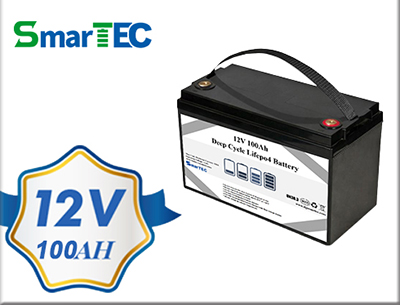LiFePO4 batteries are a popular and dependable solution for energy storage. Whether you use them for solar systems, electric vehicles, RVs, golf carts, bass boats, or other applications, it’s crucial to understand how to use them.
To get the most out of your LiFePO4 batteries, there are some things you need to pay attention to:
1. Battery Charging
Efficient charging is essential for extending battery life. For instance, the recommended charger for SmarTEC 12V 100Ah LiFePO4 lithium battery should support LiFePO4 battery charging. To fully charge the battery, the DC charging voltage must be between 14.2V to 14.6V, and the charging current should be less than 100A.

Attention:
- . Stay away from water while charging.
- The optimal charging temperature is 0-45℃, which increases the speed of internal chemical material movement, allowing for quicker charging. This results in shorter charging times.
- After charging, do not keep your charger and LiFePO4 battery in close proximity.
2. Embrace Battery Protection
Integrate a quality battery management system (BMS) to protect your LiFePO4 batteries. Lithium batteries occasionally over-discharge. The lowest voltage at which you can discharge a LiFePO4 battery is 8.8V.
The SmarTEC LiFePO4 battery has a built-in BMS that monitors voltage, current and temperature to protect it from overcharge, overdischarge, overcurrent and short circuit, along with an excellent self-discharge rate. Without BMS protection, the battery can be destroyed by over-discharging even slightly below this voltage, and the destruction would be irreversible, meaning that if you discharge the battery below 8.8V, the damage would be permanent.
3. Temperature Effect
Temperature is one of the critical factors that can affect battery performance. LiFePO4 batteries operate optimally within a specific temperature range of -20℃ to 60℃. Extremely high or low temperatures can affect their capacity and lifespan. The lower the temperature, the lower the available capacity. Protect your batteries from extreme conditions whenever possible.
4. Avoid Deep Discharge
Although LiFePO4 batteries are more tolerant of deep discharge than some other types, it’s generally recommended to avoid deep discharge whenever possible. This is because LiFePO4 batteries have a limited number of charge cycles, and frequent deep discharges can stress the battery cells and reduce their overall life. Ideally, LiFePO4 batteries should be recharged when they reach 20-30% capacity.
5. How to Storage
If you’re not going to use your LiFePO4 battery for an extended period of time, it’s important to store it properly to prevent damage. Make sure they are charged to about 50% and stored in a cool, dry place out of direct sunlight. Check and recharge stored batteries regularly to maintain optimal health.
6. Quality is Paramount
Finally, it’s important to choose high-quality LiFePO4 batteries from reputable manufacturers. While there are many cheaper LiFePO4 batteries on the market, they often have lower energy density and shorter lifespans than their more expensive counterparts.
Quality batteries come with reliable BMS and undergo stringent testing, so investing in a high-quality LiFePO4 battery can save you money in the long run by providing better performance and a longer lifespan.
Conclusion
LiFePO4 batteries offer a reliable and efficient energy storage solution, but their proper use is key to maximizing their potential. By following these guidelines, you can ensure that your LiFePO4 battery performs optimally and lasts for many years to come.

